
PREV ARTICLE
NEXT ARTICLE
FULL ISSUE
PREV FULL ISSUE
CNG TRITON XXI SALE HIGHLIGHTSKerry Wetterstrom of Classical Numismatic Group forwarded this press release for the firm's Triton XXI sale. Thanks! These are some marvelous, classic coins, with great
pedigrees. -Editor
Classical Numismatic Group of Lancaster, Pennsylvania and London, England is proud to present Triton XXI, a Public, Internet, and Mail Bid Sale to be held in conjunction with the 46 th Annual New York International Numismatic Convention (NYINC) on January 9-10, 2018. The 2018 NYINC will be held at a new venue – the Grand Hyatt Hotel, located at 109 East 42 nd Street, New York, NY 10022, between Park and Lexington Avenues. Triton XXI features 1570 lots of Alexandrian (Roman Egypt), ancient Greek, Celtic, Oriental Greek, Central Asian, Roman Republican & Imperatorial, and Roman Imperial coinage. Additionally, there are featured selections of Byzantine, Early Medieval, Islamic, World, and British Coinage, as well as British Medals and a nice selection of large lots. The pre-sale estimate total for Triton XXI is over $10 million. Triton XXI is highlighted by a number of collections and individual rarities, which make up the majority of coins on offer:
Lot viewing for Triton XXI will begin on Sunday, January 7 th , from 1PM until 7PM in the Broadway Room, located on the Conference Level (4 th floor) of the Grand Hyatt Hotel. The complete lot-viewing schedule for Triton XXI is: Auction lots will also be available for viewing at the Pennsylvania offices of CNG from Friday, December 1 st , 2017 until Friday, December 22 th , 2017 by appointment only. Please note that CNG’s office hours will be limited during the holiday season. The auction sessions for Triton XXI will be held in the Empire State Ballroom I, located on the Ballroom Level (5 th floor) of the Grand Hyatt Hotel. Triton XXI will be conducted over four sessions with the morning sessions beginning promptly at 9:30 AM on Tuesday, January 9 th , and Wednesday, January 10 th , 2018, and the afternoon sessions will start at 2 PM on the same days. In addition, there will be an online, Internet-only, Session 5 for Triton XXI, which CNG will be conducting as our Electronic Auction 412, and will open for bidding on December 13 th , 2017. E-Sale 412 will feature over 1,000 lots, with a closing date of Wednesday, January 17 th , 2018, and will include coins from some of the same collections listed above. Printed catalogs for Triton XXI are now available. To order a catalog, please visit www.cngcoins.com. Both catalogs (Staffieri Collection and Triton XXI) are $75 to North American addresses, and $100 to the rest of the world. The individual Staffieri Collection catalog is available for $50 to North American addresses, and $75 to the rest of the world. Payment may be made by U.S. $ check or Visa/MasterCard. Catalogues have already been mailed to customers on CNG’s active mailing list. About the NYINC: The New York International Numismatic Convention is the United States’ most prestigious numismatic event targeting the needs of the world and ancient numismatic communities. The 46 th Annual NYINC will be held at the Grand Hyatt Hotel, located at 109 East 42nd Street, New York, NY 10022, between Park and Lexington Avenues. The dates for the 2018 NYINC are Friday, January 5th , 2018 through Sunday January 14 th , 2018, with bourse activities taking place Thursday-Sunday, January 11-14, 2018. Just a few of the individual highlights from Triton XXI are: 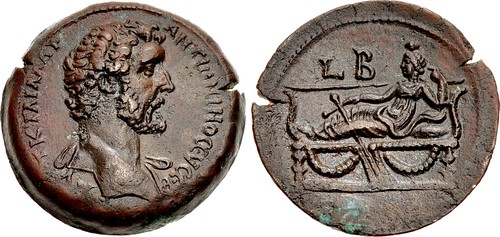 Lot 112–EGYPT, Alexandria. Antoninus Pius. AD 138-161. Æ Drachm (35mm, 25.45 g, 12h). Dated RY 2 (AD 138/139). AV T K T AI? A?P ANT?NINOC ?VC?B, bareheaded bust right, slight drapery / Tyche reclining left on lectisternium (couch), holding rudder with her right hand, resting her left elbow on pile of pillows and propping her head on hand; L B (date) above. Köln 1312-3 var. (obv. bust type); Dattari (Savio) 8765 (this coin, obv. photo is incorrect in the plates); K&G 35.33 var. (same); Emmett 1687.2; Staffieri, Alexandria In Nummis 111 (this coin). EF, attractive reddish brown patina with touches of green. Another early portrait of exquisite execution, which is far superior to any at auction since 2000 for this regnal year. Estimated at $3,000 From the Giovanni Maria Staffieri Collection, purchased from Renzo Canavesi, Sagno, 1996. Ex Renzo Canavesi Collection (Sagno); Dr. Piero Beretta Collection (Milan); Giovanni Dattari Collection, no. 8765.  Lot 152–EGYPT, Alexandria. Antoninus Pius. AD 138-161. Æ Drachm (35mm, 27.94 g, 12h). Labors of Herakles series. Dated RY 4 (AD 140/141). AYT K T AI? A?P • ANT?NINOC • ?YC?B •, laureate head right / Herakles and the Cerynean Hind – Herakles standing right, grasping the antlers of the Cerynean Hind with both hands and leaning on its back with his left knee; behind, Herakles’ club upright; L T? TAPTOV (date) around. Köln –; Dattari (Savio) 8491 (this coin); K&G –; Emmett 1547.4 (R3); Staffieri, Alexandria In Nummis 151 (this coin). Good VF, lovely dark brown patina with smooth surfaces. Very rare. A masterpiece. Only two far inferior examples have been sold at auction since 2000. Estimated at $15,000 From the Giovanni Maria Staffieri Collection, purchased from Dr. Piero Beretta, Milan, October 1976. Ex Dr. Piero Beretta Collection (Milan); Giovanni Dattari Collection, no. 8491. For his third labor, Herakles was required to capture the Cerynean hind, with its brazen hooves and golden horns, alive and bring it from Oenoe to Mycenae. Herakles chased the stag for one full year before it finally tired, and then he captured it – as shown on the coin type. This type was struck at Alexandria for Pius’ regnal years 4, 5, 6, and 10. 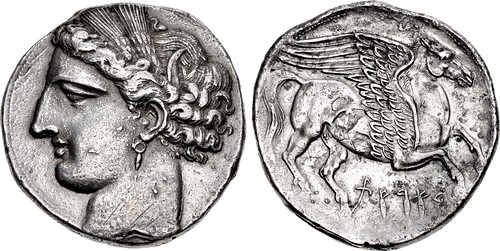 Lot 360–SICILY, Uncertain Punic mint. First Punic War. Circa 264-241 BC. AR 5 Shekels – Dekadrachm (40.5mm, 37.80 g, 1h). Head of Tanit left, wearing wreath of grain ears and single-pendant earring / Pegasos flying right; Punic B'RŠT (= “In the land”) below. Jenkins, Punic, Series 6, 451 (O5/R20 – this coin referenced); Jenkins & Lewis pl. 27, 2; CNP 350; HGC 2, 1664; SNG Stockholm 663 (same dies); Hirsch 1866 (same dies); Kraay & Hirmer 211. Good VF, toned, trace deposits, a couple small scratches and light die rust on obverse, minor metal flaws on reverse. Well struck on a broad flan. Impressive and aesthetically pleasing. Estimated at $30,000 From the Collection of a Northern California Gentleman. Ex Leu 45 (28 May 1988), lot 77; Hess-Leu 45 (12 May 1970), lot 85; Virgil Brand Collection (Hess-Leu 31, 6 December 1966), lot 180. Although since the late 6th century BC relations between Rome and Carthage had always been maintained on a friendly basis, Rome's growing influence in Magna Graecia in the early decades of the third century BC led inevitably to an increasing rivalry between the two powers. The Italian state was being drawn inexorably into the bitter politics of the centuries-old dispute between Greeks and Carthaginians in Sicily. This magnificent medallic piece was issued at about the time of the outbreak of the First Punic War, which, after almost a quarter of a century of fighting, was to bring about the end of the Carthaginian presence on the island. Find spots for these coins have been exclusively Sicilian, and they were presumably struck for military purposes. Although horses had always been popular on Carthaginian and Siculo-Punic issues, the depiction of the winged Pegasos represented a departure from tradition. The influence of the Corinthian coinage and that of her colony Syracuse seems obvious. The typically enigmatic Punic inscription translates “in the land,” and the Carthaginian stronghold of Panormos on the north coast of western Sicily has been suggested as the mint for this impressive series. Ex Harald Salvesen Collection 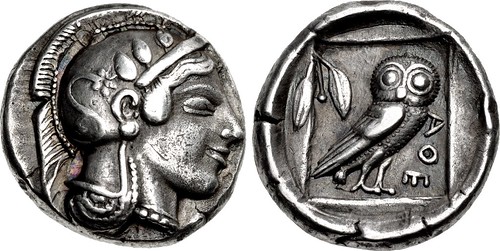 Lot 419–ATTICA, Athens. Circa 475-465 BC. AR Didrachm (19.5mm, 8.42 g, 8h). Head of Athena right, wearing earring, necklace, and crested Attic helmet decorated with three olive leaves over visor and a spiral palmette on the bowl / Owl standing right, head facing; olive sprig to left, ATE to right; all but one leaf of olive sprig within incuse square, the totality within incuse circle. Starr Group IV, 143 (O123/R135); Seltman 473 (same dies); Svoronos, Monnaies, pl. 9, 16 & 19 (same dies); HGC 4, 1617 corr. (Starr groups); SNG Copenhagen 30 (same dies); Boston MFA 1602; Hunterian 10; Rhousopoulos 1979 (same dies); K. Schefold, Meisterwerke Griechische Kunst (Basel, 1960), 458 (this coin). Near EF, beautifully toned. Well centered on a broad flan. Very rare, fewer than 50 didrachms of this type (Starr Groups II–IV) known, of which only about a dozen remain in private hands. Estimated at $50,000 Ex New York Sale IV (17 January 2002), lot 157 (purchased by Harold Salvesen); private collection in Basel (per Schefold [1960]). 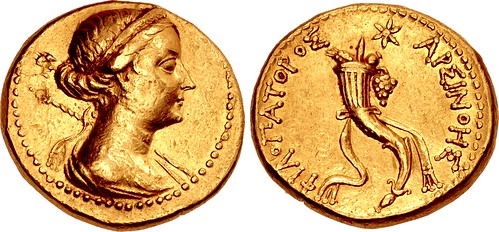 Lot 547–PTOLEMAIC KINGS of EGYPT. Arsinoë III Philopator. Died 204 BC. AV Mnaieion – “Oktadrachm” (27.5mm, 27.71 g, 12h). Uncertain military mint in Phoenicia. Struck under Ptolemy V, circa 202-200 BC. Diademed and draped bust right, wearing stephanos and single-pendant earring; transverse lotus-tipped scepter in background / APSINOHS FI?O?ATOPOS, cornucopia, grape bunch hanging at side, bound with fillet; star above. Svoronos 1269 var. (NI on rev.); Mørkholm, Portrait, obv. die A21; Leu 36, lot 218 (same obv. die); otherwise unpublished. Good VF, a few marks. Extremely rare, one of two known. Estimated at $50,000 Ex Vinchon (13 April 1985), lot 421. This issue was struck during the Fifth Syrian War (202-195 BC). It is the same obverse die as Svoronos 1269, but lacks the NI control on the reverse, which is also present on certain silver tetradrachms issued at an uncertain Ptolemaic military mint in Phoenicia during this period. In his study of this coinage, Mørkholm argued that most, if not all, of these portrait issues were struck in Phoenician mints, many of the types being die-linked with mint marked pieces from Sidon, and most of the hoards being found in that region. In addition, the interlinking of dies within each series points to a limited period of minting, perhaps for only a few years after 202 BC, when Ptolemy V was fighting a losing battle to keep his Phoenician territories from falling to Antiochos III of Syria. His portrait types, along with rarer types showing his parents Ptolemy IV and Arsinoë III, lent immediacy to the Ptolemaic presence in Phoenicia. Important Jewish Reference Aureus 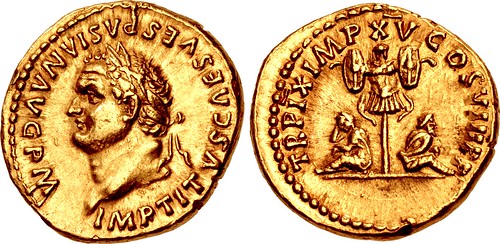 Lot 739–Titus. AD 79-81. AV Aureus (18.5mm, 7.17 g, 7h). “Judaea Capta” commemorative. Rome mint. Struck 1 January-30 June AD 80. IMP TITVS C?ES VESPASI?N ?VG P M, laureate head left / TR P IX IMP XV COS VIII P P, trophy composed of cuirass, helmet, and oblong shields; two captives seated left and right, back to back, in attitude of mourning. RIC II 101; Hendin 1579a (this coin illustrated); Calicó 778 (same dies as illustration); BMCRE –; BN –; Biaggi 379; Kölner Münzkabinett 38, lot 335 (same dies). EF, underlying luster, a few minimal marks. Very rare, especially in this high grade. Estimated at $50,000  Lot 1056–GERMANY, Schaumburg-Pinneberg (Grafschaft). Ernst. 1601-1622. AR Halbtaler (44mm, 14.25 g, 12h). Altona mint; münzmeister Christoph Feistell. Struck 1618-1620. HATS • GODT • VO • RSEHN • SO • WI RTS • GESCHEN • (God hath foreseen, so it will come about), armored figure of Ernst right on horseback, holding scepter; flowers on ground below / DIE ROTE HVR DE • DRACH : REIT • DE KELC : DS GIF : U : GREWELS • TREIT • (The whore [of Babylon] rides the red dragon, carrying the chalice of poison and cruelty), the Whore of Babylon seated right, holding raised chalice, on seven headed beast with one head severed, standing on city gate; to left, grasshopper right; to right, lamb leaping left. Lange 838; Weinmeister 162; KM 105. Good VF, toned. Estimated at $20,000 Ex Friedrich Popken Collection (Künker 244, 6 February 2014), lot 316; UBS 79 (10 September 2008), lot 3072. The Thirty Years' War was one of the longest and most destructive of European conflicts and involved most of the states of continental Europe. A religious war, it divided the continent between Roman Catholic and Protestant, with both sides viewing the conflict in specifically religious terms. Such views were widely represented on the coinage of the time, thereby conveying the sense of apocalypse felt by the inhabitants. These images became a convenient shorthand for vilifying the opposition and, in this case, the Whore of Babylon was meant to represent the Papacy. The image on this halbtaler derives from Revelation 17:3-4 – “and I saw a woman sit upon a scarlet colored beast, full of names of blasphemy, having seven heads and ten horns. And the woman was arrayed in purple and scarlet colour, and decked with gold and precious stones and pearls, having a golden cup in her hand full of abominations and filthiness of her fornication.” The county Schaumberg-Pinneberg had originally been Roman Catholic until the time of Otto IV (circa 1531-1576), who adopted Lutheran teachings, but did not openly confront the Church, since his brothers each were Archbishop-Electors of Cologne. By the time of Ernst, however, Schaumberg-Pinneberg was Lutheran. Because of this, the county did experience some war damage during the Thirty Years’ War. Following Ernst’s death in 1622, he was succeeded by a Roman Catholic relative, Jobst Herman, who ruled without attempting to change the religion of the territories under his rule. His successor, Otto V, (1635-1640) was a Calvinist, though he himself did not try to steer his territories away from Lutheranism, which its inhabitants continue to follow to today.  Lot 1127–POLAND, Monarchy. Zygmunt III Wasa. 1587-1632. AV 100 Dukat (70mm, 349.49 g, 12h). Commemorating the victory over the Turks at Chocim (Khotyn). Bydgoszcz (Bromberg) mint; Jacob Jacobson van Emden, mintmaster, and Samuel Ammon, engraver. Dated 1621 II VA SA. * SIGISMVNDVS · III · D : G : POLONIÆ · ET · SVECIÆ · REX *, armored and draped bust right, wearing ruff and collar of the Order of the Golden Fleece; all within oak wreath border / * MAGNVS · DVX · LITVAN : RVSS : : PRVSS : MAS : SAM : LIVON : ZC’ : *, crowned ornate coat-of- arms within collar of the Order of the Golden Fleece; II and SA within garnish; all within oak wreath border. Czapski 1414; Kopicki 1441; Kurpiewski 1770; Gumowski –; KM H43; Friedberg 72 (this coin cited); Kaleniecki p. 108 (this coin cited). EF, scattered handling marks and hairlines, die break on reverse. One of six total specimens known, and the only example to be offered at auction since 2008. Estimated at $2,000,000 Ex Kroisos Collection (Stack’s, 14 January 2008), lot 3091 (where it appears on the cover); G. Hirsch 53 (26 June 1967), lot 210 (where it appears on the cover). Like the 1629 Coronation 100 Dukát of Ferdinand III, and the 1677 100 Dukát of Mihály Apafi I, this 100 Dukat of Zygmunt III Wasa is one of the largest European gold pieces ever struck. When this coin sold in 2008, it realized $1,380,000 (including the 15% buyer’s fee); the highest price realized for a gold coin to that date. Six examples of this issue are known, all from a single pair of dies: The son of Johann III of Sweden and his first wife, Katarzyna Jagiellonka of Poland, Zygmunt III Wasa was elected to the throne of the Polish-Lithuanian Commonwealth in 1587. Still a controversial figure in Poland, his long reign as its king (1587-1632), coincided with the high point of the Polish-Lithuanian Commonwealth. Hoping to create a personal union between the Commonwealth and Sweden, he used his position to take the Swedish throne in 1592, upon the death of his father. Fearing that Zygmunt might use this as an opportunity to re-establish Roman Catholicism in Protestant Sweden, Zygmunt's uncle, Karl (later to become Karl IX), became the leader of the Protestant opposition in Sweden. As king-elect, Zygmunt was forced to confirm the resolutions of the 1593 Uppsala Synod, by recognizing that Sweden was a Lutheran Protestant state. Under this agreement, Karl, along with the Swedish Privy Council, would share power with the king and rule in his place, since Zygmunt remained in Poland. Following Zygmunt's coronation as King of Sweden on 19 February 1594, the new king engaged in a series of reactionary policies designed to curb the power of the Swedish nobility. He ordered that no Parliaments be summoned without his consent. In return, the Swedish Parliament elected Karl as regent. In sympathy with the king, the nobility of Finland (then a part of the Swedish Kingdom), led by Klaus Fleming, rejected this appointment, considering Karl to be a rebel. To counterattack Fleming, Karl instigated a rebellion among the local peasants. Known as the Cudgel War (1596-1597), this rebellion precipitated a larger civil war between Sweden and the Polish-Lithuanian Commonwealth. Through a series of battles in 1598, the Swedish forces under Karl eventually forced the king to accept a peace treaty, under which Zygmunt would be officially deposed and his son, Wladyslaw IV Vasa, would be sent to Sweden as his successor, provided the boy would be brought up as a Protestant. When Zygmunt failed to respond to these demands, the Swedish Parliament elected Karl as the new king. As King of Poland, Zygmunt's primary goals were to create a strong and stable Polish government, as well as combating heresy in all its forms. While such policies were unsuccessful in Sweden, he was more successful against the Ottomans. Viewed as a Christian bulwark against the Turks, Zygmunt was eager to assist Austria. Promised territorial gains for the kingdom in return for his assistance, Zygmunt sent mercenaries to the Principality of Moldavia to extricate the Ottomans from the area. At the Battle of Chocim (modern Khotyn) in 1621, the Polish-Lithuanian Commonwealth held the forces of Sultan Osman II and his Janissaries at bay until the first autumn snows. Aided by the Polish hussars, a heavy cavalry known as winged, because their armor included a pair of wings on their back, the Ottomans, sustaining heavy losses, were forced to abandon the field. Although indecisive in its outcome, the battle – the largest in the history of the Commonwealth to date – was proclaimed a great victory over the “heathens”, and became subsequently an event of great cultural pride in succeeding years (see, for example, Waclaw Potocki's, Transakcja wojny chocimskiej [The Progress of the War of Chocim], written between 1669 and 1672). Struck by Jacob Jacobson van Emden, with dies engraved by Samuel Ammon, this impressive gold 100 Dukat was struck to commemorate this victory.  Lot 1188–TRANSYLVANIA, Principality. Gábor Bethlen. 1613-1629. AR Taler (42mm, 10h). Körmöcbánya (Kremnitz / Kremnica) mint. Dated 1621 KB. * GABRIEL D ? G ? EL ? HVNGARIÆ ? DAL ? CR SCL ? REX, armored half-length bust right, holding scepter over right shoulder; coat-of- arms and Madonna with child in legend / ? TRANS ? PRINCEPS ? ET ? SICVLOR ? COM ? 1621 ?, crowned coat-of- arms; K B flanking. Resch 91; MBR 1308; KM 134; Davenport 4710. In NGC encapsulation graded XF Details, edge filed, cleaned. Toned. Estimated at $2,000 From the Princeps Collection. 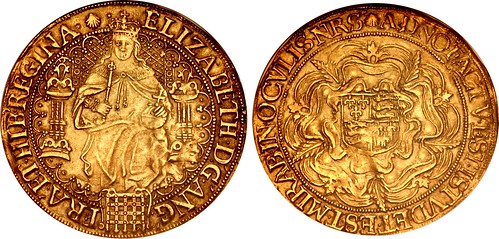 Lot 1438–TUDOR. Elizabeth I. 1558-1603. AV Sovereign (43mm, 1h). Sixth issue. Tower (London) mint; im: escallop. Struck 1584-1586. ELIZABETH · D’ · G’ · ANG’ · FRA’ · ET : HIB’ · REGINA · (escallop), Elizabeth, holding lis-tipped scepter in left hand, right hand set on globus cruciger propped on her knee, seated facing on ornate throne with pellets on back and pillars with annulets and double pellets; all within tressure of arches; portcullis (with chains) below / (escallop) A · DNO’ · FACTV’ · EST · ISTVD · ET · ES·T · MIRAB · IN · OCVLIS · NRS’, royal shield in center of Tudor rose. Brown & Comber A11 (but no indication of scallop over A on rev.); Schneider –; North 2003; SCBC 2529. In NGC encapsulation, graded AU 55. Estimated at $20,000 From the Jonathan P. Rosen Collection. For further details and any additional information, please contact CNG, Inc. at: Classical Numismatic Group, Inc. THE BOOK BAZARREOVER 500 NUMISMATIC TITLES: Wizard Coin Supply has over 500 numismatic titles in stock, competitively discounted, and available for immediate shipment. See our selection at www.WizardCoinSupply.com.Wayne Homren, Editor The Numismatic Bibliomania Society is a non-profit organization promoting numismatic literature. See our web site at coinbooks.org. To submit items for publication in The E-Sylum, write to the Editor at this address: whomren@gmail.com To subscribe go to: https://my.binhost.com/lists/listinfo/esylum All Rights Reserved. NBS Home Page Contact the NBS webmaster 
|